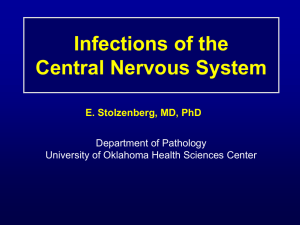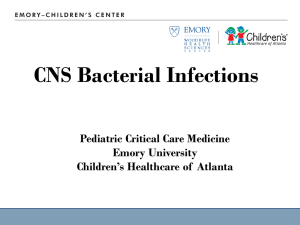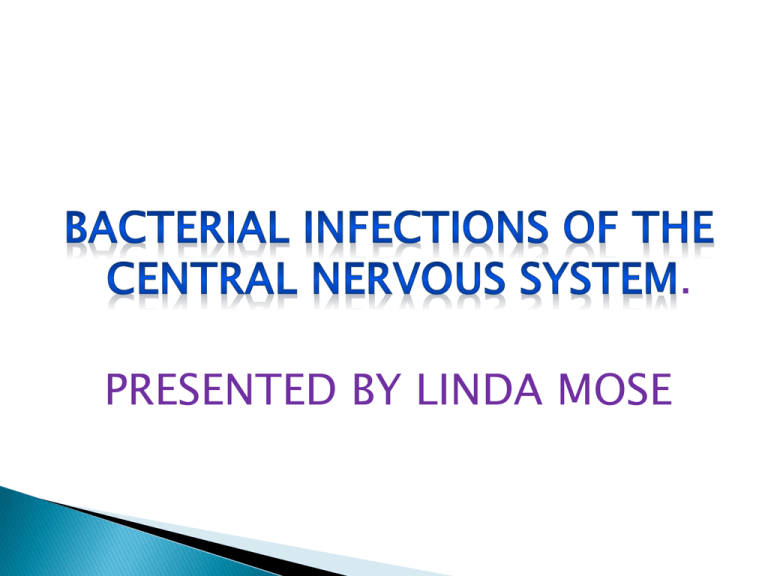
.
PRESENTED BY LINDA MOSE
Clinical features of infections of the nervous
system depend upon the location of the
infection ( in the meninges or in the
brain/spinal cord parenchyma), the causative
agent (ie bacterial infections, viral infections,
slow virus and prion infections, parasitic
infections, fungal infections) and whether the
infection is acute or chronic.
Bacterial CNS infections may occur as:
◦ Meningitis
◦ Parenchymal bacterial infections
◦ An infection of the central nervous system may primarily
affect its coverings, which is called meningitis. It may
affect the brain parenchyma, called encephalitis, or
affect the spinal cord, called myelitis. A patient may have
more than one affected area, and if all are affected, the
patient has "meningoencephalomyelitis". The nervous
system may also suffer from localized pockets of
infection. Within the brain or spinal cord there may be an
abscess, and outside them there may be an epidural
abscess or subdural empyema.
Meningitis is inflammation of the protective
membranes covering the brain and spinal
cord, known collectively as the meninges.
The inflammation may be caused by infection
with viruses, bacteria, or other
microorganisms, and less commonly by
certain drugs.
Meningitis can be life-threatening because of
the inflammation's proximity to the brain and
spinal cord; therefore the condition is
classified as a medical emergency.
ANATOMY
The meninges comprise three membranes that, together
with the cerebrospinal fluid, enclose and protect the brain
and spinal cord (the central nervous system).
The pia mater is a very delicate impermeable membrane
that firmly adheres to the surface of the brain, following
all the minor contours.
The arachnoid mater (so named because of its spiderweb-like appearance) is a loosely fitting sac on top of the
pia mater.
The subarachnoid space separates the arachnoid and pia
mater membranes, and is filled with cerebrospinal fluid.
The outermost membrane, the dura mater, is a thick
durable membrane, which is attached to both the
arachnoid membrane and the skull.
In bacterial meningitis, bacteria reach the meninges by one of
two main routes: through the bloodstream or through direct
contact between the meninges and either the nasal cavity or the
skin.
In most cases, meningitis follows invasion of the bloodstream by
organisms that live upon mucous surfaces such as the nasal
cavity. This is often in turn preceded by viral infections, which
break down the normal barrier provided by the mucous surfaces.
Once bacteria have entered the bloodstream, they enter the
subarachnoid space in places where the blood-brain barrier is
vulnerable—such as the choroid plexus.
Direct contamination of the cerebrospinal fluid may arise from
indwelling devices, skull fractures, or infections of the
nasopharynx or the nasal sinuses that have formed a tract with
the subarachnoid space; occasionally, congenital defects of the
dura mater can be identified.
The large-scale inflammation that occurs in the
subarachnoid space during meningitis is not a direct
result of bacterial infection but can rather largely be
attributed to the response of the immune system to
the entrance of bacteria into the central nervous
system.
When components of the bacterial cell membrane are
identified by the immune cells of the brain (astrocytes
and microglia), they respond by releasing large
amounts of cytokines, hormone-like mediators that
recruit other immune cells and stimulate other
tissues to participate in an immune response.
The blood-brain barrier becomes more permeable,
leading to "vasogenic" cerebral edema (swelling of the
brain due to fluid leakage from blood vessels).
Large numbers of white blood cells enter the CSF,
causing inflammation of the meninges, and leading
to "interstitial" edema (swelling due to fluid between
the cells).
In addition, the walls of the blood vessels themselves
become inflamed (cerebral vasculitis), which leads to
a decreased blood flow and a third type of edema,
"cytotoxic" edema.
The three forms of cerebral edema all lead to an
increased intracranial pressure; together with the
lowered blood pressure often encountered in acute
infection, this means that it is harder for blood to
enter the brain, and brain cells are deprived of
oxygen and undergo apoptosis (automated cell
death).
Headache
Fever
Meningismus – nuchal rigidity
Obtundation - greatly reduced consiousness level
Photophobia
Phonophobia
Vomiting and nausea
Meningococcal rash
Altered mental state/confusion
Drowsiness
Convulsions
Coma
In children symptoms may not be characterisitc and one may
report irritability, bulging anterior fontanelle in children < 6
months, cold extremeties, inactivity, refusal to feed
The stiff neck that occurs in meningitis is often striking--it is
really stiff, almost boardlike, but not so painful as it is stiff. The
stiffness is caused by reflex spasm of the neck muscles due to
traction on inflamed cervical nerve roots. It is greatest with
flexion, less with extension or rotation. Of course, a lot of older
people have necks that are quite stiff due to osteoarthritis, and if
they have a fever, this may occasionally lead to diagnostic
concern for meningitis. Usually their necks are stiff with both
rotational and flexion/extension movement. Associated with the
stiff neck are two other classic "meningeal signs", the signs of
Kernig and Brudzinski. Brudzinski's sign is involuntary flexion of
the hip and knee when the examiner flexes the patient's neck.
Kernig's sign is limitation of straightening of the leg with the hip
flexed. Meningeal signs occur not only in infectious meningitis,
but in subarachnoid hemorrage and chemical meningitis.
Unfortunately, meningismus occurs only in about 50% of cases of
bacterial meningits, so the sign is neither highly specific nor
highly sensitive
The types of bacteria that cause bacterial meningitis vary by age
group. In premature babies and newborns up to three months
old, common causes are group B streptococci (subtypes III which
normally inhabit the vagina and are mainly a cause during the
first week of life) and those that normally inhabit the digestive
tract such as Escherichia coli (carrying K1 antigen), Klebsiella and
Proteus species. Listeria monocytogenes (serotype IVb) may
affect the newborn and occurs in epidemics.
Older children are more commonly affected by Neisseria
meningitidis (meningococcus), Streptococcus pneumoniae
(serotypes 6, 9, 14, 18 and 23) and those under five by
Haemophilus influenzae type B.
In adults, N. meningitidis and S. pneumoniae together cause 80%
of all cases of bacterial meningitis, with increased risk of L.
monocytogenes in those over 50 years old.
Recent trauma to the skull gives bacteria in the nasal
cavity the potential to enter the meningeal space.
Similarly, individuals with a cerebral shunt or related
device (such as an extraventricular drain or Ommaya
reservoir) are at increased risk of infection through
those devices. In these cases, infections with
staphylococci are more likely, as well as infections by
pseudomonas and other Gram-negative bacilli.
The same pathogens are also more common in those
with an impaired immune system.
In a small proportion of people, an infection in the
head and neck area, such as otitis media or
mastoiditis, can lead to meningitis.
Recipients of cochlear implants for hearing loss are at
an increased risk of pneumococcal meningitis.
Tuberculous meningitis, meningitis due to infection
with Mycobacterium tuberculosis, is more common in
those from countries where tuberculosis is common,
but is also encountered in those with immune
problems, such as AIDS.
Recurrent bacterial meningitis may be caused by
persisting anatomical defects, either congenital or
acquired, or by disorders of the immune system.
Anatomical defects allow continuity between the
external environment and the nervous system. The
most common cause of recurrent meningitis is skull
fracture, particularly fractures that affect the base of
the brain or extend towards the sinuses and petrous
pyramids.
Aseptic
The term aseptic meningitis refers loosely to all cases of
meningitis in which no bacterial infection can be
demonstrated.
This is usually due to viruses, but it may be due to
bacterial infection that has already been partially treated,
with disappearance of the bacteria from the meninges, or
by infection in a space adjacent to the meninges (e.g.
sinusitis).
Endocarditis (infection of the heart valves with spread of
small clusters of bacteria through the bloodstream) may
cause aseptic meningitis.
Aseptic meningitis may also result from infection with
spirochetes, a type of bacteria that includes Treponema
pallidum (the cause of syphilis) and Borrelia burgdorferi
(known for causing Lyme disease).
This organism is now the most common cause of bacterial meningitis in
all age groups except newborns. It is a Gram-positive coccus that occurs
in pairs. It has an external polysaccharide capsule that determines its
serotype.
Serotype is important for vaccine creation and epidemiology, but is not
routinely performed on clinical isolates, and does not guide antibiotic
therapy.
The nasopharynx is the primary site of pneumococcal colonization.
Spread is from person to person through droplets, so there is an
increased chance of spread in day care centers, barracks and prisons.
The organism may spread to the meninges through local extension from
an infected sinus or middle ear infection. Because it colonizes the
nasopharynx this strain is common when meningitis occurs as a
consequence of ENT procedures or of chronic CSF leak.
Major risk factors for meningitis with this organism are: splenectomy,
diabetes mellitus, liver disease, alcoholism, CSF leak, terminal
complement deficiency, and pneumococcal pneumonia.
Treatment and prevention
For many years, S. pneumoniae was reliably sensitive
to penicillin. Meningitis caused by these strains
responds to meningitis doses of penicillin, ampicillin,
cefotaxime, or ceftriaxone.
In recent years, penicillin-resistant strains have
become common.
These strains remain susceptible to the third
generation cephalosporins ceftriaxone and
cefotaxime.
Vancomycin plus Rifampicin
Chlormaphenicol
Like pneumococcal pneumonia, meningitis can be
prevented with pneumococcal conjugate vaccine.
H. influenzae is a small (1-2 micrometer
diameter) Gram-negative coccobacillus.
Strains causing meningitis in children almost all
have an outer capsule, but non-meningitiscausing strains do not.
The organism colonizes the upper respiratory
tract of humans, who are its only natural host.
Spread occurs through respiratory droplets or by
direct contact with respiratory secretions.
Risk factors for meningitis include head trauma,
neurosurgery, paranasal sinusitis, otitis media
and CSF leak.
Treatment and prevention
H. influenzae meningitis can be prevented by
use of H. influenzae conjugate vaccine.
As with S. pneumoniae, beta-lactam and
ampicillin-resistant strains are increasingly
found, but resistance to ceftriaxone or
cefotaxime are rare, and these are the drugs
of choice.
Chlormaphenicol may also be used
Listeria monocytogenes is a facultatively anaerobic Gram-
positive rod.
The organism can be found in human feces, unpasteurized
milk, cheeses, and other foods.
Most cases are sporadic, and contaminated food is the
source of infection.
It may be difficult to diagnose clinically, because
compared to other meningitides meningeal signs are less
frequent, there is a lower CSF WBC count, less neutrophilic
predominance, and lower protein.
Cranial nerve dysfunction may occur, and there are
occasional cases of brainstem encephalitis.
Listeria monocytogenes is a common cause of meningitis
in infants less than 1 month old, and is also common in
adults greater than 60 years old. Risk factors include
pregnancy, advanced age, and immunosuppression.
Treatment and prevention
Listeria monocytogenes remains sensitive to
penicillins, and ampicillin is the antibiotic of
choice, but treatment must be prolonged--3 or 4
weeks.
Trimethoprim-sulfamethoxasole is an
alternative for the penicillin-allergic patient.
Gentamicin can also be used in combination with
ampicillin.
Listeriosis results from food-borne transmission,
so proper food handling measures markedly
reduces infection risk.
This is the most common meningitis in infants less
than 1 month of age (70% of cases).
Transmission to the neonate usually occurs from
mothers colonized by group B streptococcus in the
genital tract.
In adults, group B streptococcal infection is often
nosocomial.
Treatment and prevention
Beta-lactam-resistant strains of group B
streptococcus have not emerged.
Treatment is with penicillin and ampicillin.
Neonatal meningitis can be prevented by therapies
aimed at reducing maternal birth canal colonization,
or by Caesarian section.
Neisseria meningitidis is an encapsulated Gram-negative
organism that appears in pairs on Gram stain.
It commonly colonizes the nasopharynx, and can spread rapidly
from person to person through respiratory droplets. N.
meningitidis often occurs in epidemics among persons living in
close quarters like dormitories or barracks.
The course of the illness is usually rapid and dramatic. A
petechial rash on the trunk and lower body may coalesce into
purpura, which is a sign of disseminated meningococcemia and
disseminated intravascular coagulation. Distal extremity necrosis
may also occur.
Treatment is effective and the disease usually occurs in
immunocompetent patients. It is common to have non-lethal
complications such as cutaneous scars, amputation, hearing loss,
and renal injury.
As with other encapsulated organisms, asplenia is a risk factor
for infection.
Treatment and prevention
Penicillin-resistant strains are uncommon, so drugs of choice are
penicillin or ampicillin.
Ceftriaxone or cefotaxime response is also excellent.
A polysaccharide vaccine has been available for a number of
years and routinely recommended for all adolescents, such as
college freshmen or military recruits. It has also been useful in
patients with risk factors such as asplenia. Since 2005 a
conjugate vaccine has been available.
Close contacts of patients have a significantly increased risk of
contracting infection, so antimicrobial prophylaxis is
recommended for household members, day care contacts, and
others.
This should be done within 24 hours after exposure because
secondary disease occurs within several days.
One dose of ciprofloxacin or ceftriaxone is an alternative, and
ceftriaxone can be given to pregnant patients.
Age
Major pathogens
Antibiotics
less than 3 months
group B strep.
ampicillin
E. coli
+ cefotaxime
L. monocytogenes
S. pneumoniae
3 months to 50 years
S. pneumoniae
N. meningitidis
H. influenzae (now
rare in USA)
3rd generation
cephalosporin (1)
+ vancomycin (2)
Organism
Drug of
choice (1)
Second
choice if
allergic
Duration of
therapy
group B
streptococci
penicillin G
or ampicillin
vancomycin
14 - 21 days
H.
influenzae
3rd
generation
chloramphen
7 - 10 days
cephalospori icol
n
L.
monocytoge
nes
ampicillin +
gentamycin
trimethopri
msulfamethox
asole
N.
penicillin G
chloramphen
14 - 21 days
M tuberculosis is an aerobic gram-positive rod that stains poorly
because of its thick cell wall that contains lipids, peptidoglycans,
and arabinomannans. Mycobacteria vary in appearance from
spherical to short filaments, which may be branched. Although
they appear as short to moderately long rods, they can be curved
and frequently are seen in clumps. Individual bacilli generally are
0.5-1 µm in diameter and 1.5-10 µm long. They are nonmotile
and do not form spores.
One of the distinct characteristics of mycobacteria is their ability
to retain dyes within the bacilli that usually are removed from
other microorganisms by alcohols and dilute solutions of strong
mineral acids such as hydrochloric acid. This ability is attributed
to a waxlike layer composed of long-chain fatty acids, the
mycolic acids, in their cell wall. As a result, mycobacteria are
termed acid-fast bacilli.
The mechanisms by which neurovirulence may occur are
unknown.
The development of TBM is a 2-step process.
Mycobacterium tuberculosis bacilli enter the host by
droplet inhalation, the initial point of infection being the
alveolar macrophages.
Localized infection escalates within the lungs, with
dissemination to the regional lymph nodes to produce the
primary complex.
During this stage, a short but significant bacteremia is
present that can seed tubercle bacilli to other organs in
the body.
In persons who develop TBM, bacilli seed to the meninges
or brain parenchyma, resulting in the formation of small
subpial or subependymal foci of metastatic caseous
lesions.These are termed Rich foci, after the original
pathologic studies of Rich and McCordick.
The second step in the development of TBM is an
increase in size of a Rich focus until it ruptures
into the subarachnoid space.
The location of the expanding tubercle (ie, Rich
focus) determines the type of CNS involvement.
Tubercles rupturing into the subarachnoid space
cause meningitis.
Those deeper in the brain or spinal cord
parenchyma cause tuberculomas or abscesses.
While an abscess or hematoma can rupture into
the ventricle, a Rich focus does not.
A thick gelatinous exudate infiltrates the cortical
or meningeal blood vessels, producing
inflammation, obstruction, or infarction.
Basal meningitis accounts for the frequent
dysfunction of cranial nerves (CNs) III, VI, and VII,
eventually leading to obstructive hydrocephalus
from obstruction of basilar cisterns.
Subsequent neurological pathology is produced
by 3 general processes: adhesion formation,
obliterative vasculitis, and encephalitis or
myelitis.
Tuberculomas are conglomerate caseous foci
within the substance of the brain, as shown in
the image below.
Centrally located, active lesions may reach
considerable size without producing
meningitis.
Under conditions of poor host resistance, this
process may result in focal areas of cerebritis
or frank abscess formation, but the usual
course is coalescence of caseous foci and
fibrous encapsulation (ie, tuberculoma).
Clinical features resemble those of other
bacterial meningitis and include: headache;
vomiting; low-grade fever; lassitude;
depression; confusion; behavioural change
Signs include: meningism (may be absent);
oculomotor palsies; papilloedema; depression
of conciousness level; focal hemisphere signs
Diagnosis requires high index of suspicion
with careful inquiry into history and physical
findings.
CSF studies can be conducted ie MCS, ZN
stain
Cranial CT scan
First-line therapy includes INH, RIF, PZA, SM, and
ethambutol.
Second-line therapy includes ethionamide,
cycloserine, PAS, aminoglycosides, capreomycin,
and thiacetazone.
Potential new agents include oxazolidinone and
isepamicin. Fluoroquinolones useful in the
treatment of TBM include ciprofloxacin,
ofloxacin, and levofloxacin.
Because of the intensity of the inflammatory and
fibrotic reactions at the meningeal site,
adjunctive corticosteroids, in addition to
standard antituberculous therapy, is
recommended in TM.
PARENCHYMAL
INFECTIONS
BACTERIAL
Etiology
Abscesses may arise by spread from an intracranial
infection such as mastoiditis, but usually are spread to
brain through the blood stream. Hematogenous spread
from heart or lungs is most common. Congential heart
disease with right to left shunting, pulmonary A-V fistulas,
bronchiectasis, and lung abscess are all risk factors.
Bacterial endocarditis is usually only a minor risk factor for
brain abscess.
Streptococcus viridans is the most commonly isolated
organism, but abscesses are usually polymicrobial, and
Staphylococcus aureus, hemolytic Streptococcus,
Enterobacteriaciae, Bacteroides and other anaerobes, are
also common. In immunocompromised patients, fungal or
Toxoplasma gondii abscesses may occur.
Symptoms and signs
Headache
Focal neurologic deficits
Fever, chills and other signs of infection
usually do not occur
Papilledema (with increased ICP)
Nausea, vomiting (with increased ICP)
Diagnosis
Focal neurologic deficit or seizure suggests focal
brain lesion
The patient may have a risk factor for abscess, such
as:
◦
◦
◦
◦
congenital heart disease with right to left shunt
bacterial endocarditis
lung abscess or bronchiectasis
paranasal sinusitis
Contrast-enhanced CT or MRI may show a ringenhancing lesion or lesions and surrounding brain
edema
If the diagnosis is in doubt, a stereotaxic brain biopsy
will confirm that the lesion is an abscess
Cerebrospinal fluid
Lumbar puncture is not usually performed
because abscess creates an intracranial mass
with edema, so there is a risk of brain
herniation.
If the abscess is well-encapsulated, protein
may be increased, but cell counts are usually
low and cultures are usually negative, so the
diagnostic usefulness of LP is limited even if
the physician is bold enough to do it.
Treatment
If the abscess is small and not causing severe
neurologic deficit, presumptive antibiotic
therapy can be given--usually a combination
regimen that covers both aerobic and
anaerobic organisms is needed.
If the abscess grows or fails to resolve, then
surgery will be needed for diagnosis and
drainage.
Subdural empyema is a collection of pus in
the subdural space, usually arising by direct
spread from an intracranial infection such as
sinusitis, osteomyelitis of the skull vault or
middle ear disease.
Signs and symptoms are like those of brain
abscess, but seizures are especially common,
and treatment essentially always requires
surgical drainage.
Diagnosis – cranial CT scan or MRI
Spinal epidural abscess produces a rapid-onset spinal cord syndrome.
Infection usually haematogenous
The most common cause is S. aureus.
Symptoms
Fever
Back pain
Limb weakness or sensory changes
Bowel or bladder dysfunction
Symptoms are those of spinal cord dysfunction: weakness, sensory
changes, bladder or bowel dysfunction. In the case of epidural abscess,
localized back pain and fever are very common.
Signs
Signs are those of spinal cord dysfunction: paraparesis, sensory level,
hyporeflexia or hyperreflexia with extensor plantar responses, loss of
anal reflexes, loss of anal tone and loss of bulbocavernosus reflex. .
Diagnosis
Characteristic signs and symptoms.
MRI of the spine at the level suggested by the
clinical exam.
LP is contraindicated in spinal epidural
abscess because: 1) by needling the abscess
you may seed the CSF with bacteria, causing a
meningitis, 2) you may precipitate spinal
block, with immediate complete paraplegia.
Spinal epidural abscess is a medical
emergency because loss of function can be
prevented by prompt surgical drainage of the
abscess, but if diagnosis or treatment is
delayed until paraplegia occurs, recovery is
very poor.
Appropriate antibiotic therapy is essential.
Tetanus, also called lockjaw, is a medical condition characterized
by a prolonged contraction of skeletal muscle fibers.
The primary symptoms are caused by tetanospasmin, a
neurotoxin produced by the Gram-positive, obligate anaerobic
bacterium Clostridium tetani. Infection generally occurs through
wound contamination and often involves a cut or deep puncture
wound.
Neonatal through infection of umbilical stump when childbirth
occurs under unhygienic conditions.
Spores germinate and bacilli multiply in anaerobic conditions
which occurs in areas of tissue necrosis and low oxygen tension.
Exotoxin has affinity for motor nerve endings and motor nerve
cells.
Anterior horn cells affected after toxin has passed into blood
stream ands their involvement results in rigidity and convulsions.
Symptoms occur 2 days to several weeks after injury
and
include:
Trismus – spasm of masseter muscles, causing
difficulty in opening the mouth and in chewing, hence
the term ‘lockjaw’.
Tonic rigidity involving facial muscles, neck and
trunk.
Risus sardonicus – contraction of frontalis and
muscles at the angles of the mouth.
Opisthotonous
Board like abdominal wall
Convulsions
Repeated convulsions may lead to death of
patient from exhaustion, asphyxia or
aspiration pneumonia.
Autonomic involvement may cause CVS
complications such as hypertension. Other
symptoms include elevated temperature,
sweating, and episodic rapid heart rate.
Diagnosis
Usually on clinical grounds as it is rarely
possible to isolate organism from original
locus of entry
Mild tetanus
Mild cases of tetanus can be treated with:
Tetanus immunoglobulin IV or IM,
metronidazole IV for 10 days,
diazepam,
tetanus vaccination
Severe tetanus
Severe cases will require admission to intensive care. In addition to above:
human tetanus immunoglobulin injected intrathecally (increases clinical
improvement from 4% to 35%)
tracheostomy and mechanical ventilation for 3 to 4 weeks,
magnesium, as an intravenous (IV) infusion, to prevent muscle spasm,
diazepam as a continuous IV infusion,
the autonomic effects of tetanus can be difficult to manage (alternating
hyper- and hypotension, hyperpyrexia/hypothermia) and may require IV
labetalol, magnesium, clonidine, or nifedipine.
Unlike many infectious diseases, recovery from
naturally acquired tetanus does not usually result
in immunity to tetanus. This is due to the
extreme potency of the tetanospasmin toxin;
even a lethal dose of tetanospasmin is
insufficient to provoke an immune response.
Tetanus can be prevented by vaccination with
tetanus toxoid. The CDC recommends that adults
receive a booster vaccine every ten years, and
standard care practice in many places is to give
the booster to any patient with a puncture wound
who is uncertain of when he or she was last
vaccinated, or if he or she has had fewer than 3
lifetime doses of the vaccine.
Neurosyphilis is an infection of the brain or spinal cord. It occurs in
persons with untreated syphilis many years after they are first
infected.
Causes
Neurosyphilis is caused by Treponema pallidum, the bacteria that
cause syphillis. It occurs about 10 - 20 years after a person is first
infected with syphilis. Not everyone who has syphilis will develop
this complication.
There are four different forms of neurosyphilis:
Asymptomatic
General paresis(general paralysis of the insane)
Meningovascular
Tabes dorsalis
Asymptomatic neurosyphilis occurs before symptomatic syphilis.
Abnormal walk (gait)
Blindness
Confusion
Dementia
Depression
Headache
Incontinence
Inability to walk
Irritability
Loss of muscle function
Mental decline
Paralysis
Poor concentration
Seizures
Stiff neck
Tremors
Visual disturbances
Weakness, numbness of lower extremities
Note: There may be no symptoms
Signs include:
Abnormal reflexes
Muscle atrophy
Muscle contractions
Blood tests can be done to detect substances produced by
thebacteria that cause syphilis. The oldest test is the VDRL
test.
Other tests include:
Fluorescent treponemal antibody absorption (FTA-ABS)
Rapid plasma reagin (RPR)
Treponema pallidum particle agglutination assay (TPPA)
In neurosyphilis, it is important to test the spinal fluid for
signs of syphilis.
Tests to look for problems with the nervous
system may include:
Cerebral angiogram
Head CT scan
Lumbar puncture ("spinal tap") and a
cerebrospinal fluid analysis ( CSF fluid
analysis)
MRI scan of the brain, brainstem, or spinal
cord
Treatment
Penicillin is used to treat neurosyphilis. The
medicine may be given in various ways.
It may be injected into a vein every day for 10 14 days.
You may take probenecid by mouth 4 times a
day, combined with daily muscle injections -both for 10 - 14 days.
Further courses of penicillin given if symptoms
not releived or in case of clinical progression or
CSF shows presence of active disease(elevated
cell count-lymphocytic, elevated protein count
0.5-1g/l and increased gammaglobulin fraction.
Lyme disease is a bacterial illness caused by a
bacterium called a "spirochete." The actual
name of the bacterium is Borrelia burgdorferi.
Lyme disease is spread by hard ticks(ixodid)
when they bite the skin, which permits the
bacterium to infect the body.
Lyme disease is not contagious from an
affected person to someone else.
Lyme disease can cause abnormalities in the
skin, joints, heart, and nervous system.
stage 1: Early localized infection
Common bullseye rash pattern associated with Lyme disease
erythema chronicum migrans (also erythema migrans or EM), occurs at
the site of tick bite 3 to 30 days after bite
Patients can also experience flu-like symptoms such as headache,
muscle soreness, fever, and malaise.Lyme disease can progress to later
stages even in patients who do not develop a rash.
Stage 2: Early disseminated infection
Erythema chronicum migrans may develop at sites across the body that
bear no relation to the original tick bite. borrelial lymphocytoma, a
purplish lump may develops on the ear lobe, nipple, or scrotum.Other
discrete symptoms include migrating pain in muscles, joint, and
tendons, and heart palpitations and dizziness caused by changes in
heartbeat.
Acute neurological problems, appear in 15% of untreated patients These
include facial or Bell's palsy, as well as meningitis. Radiculoneuritis
causes shooting pains that may interfere with sleep as well as abnormal
skin sensations. Mild encephalitis may lead to memory loss, sleep
disturbances, or mood changes.
Stage 3: Late persistent infection
After several months, untreated or inadequately treated patients may go on to
develop severe and chronic symptoms that affect many parts of the body,
including the brain, nerves, eyes, joints and heart. Myriad disabling symptoms can
occur, including permanent paraplegia in the most extreme cases.
Chronic neurologic symptoms occur in up to 5% of untreated patients.
A polyneuropathy that involves shooting pains, numbness, and tingling in the
hands or feet may develop.
A neurologic syndrome called Lyme encephalopathy is associated with subtle
cognitive problems, such as difficulties with concentration and short-term
memory. These patients may also experience profound fatigue.
depression
fibromyalgia
Chronic encephalomyelitis, which may be progressive, can involve cognitive
impairment, weakness in the legs, awkward gait, facial palsy, bladder problems,
vertigo, and back pain.
In rare cases untreated Lyme disease may cause frank psychosis, which has been
mis-diagnosed as schizophrenia or bipolar disorder. Panic attack and anxiety can
occur, also delusional behavior, including somatoform delusions, sometimes
accompanied by a depersonalization or derealization syndrome, where the person
begins to feel detached from themselves or from reality.]
Serological tests eg Western Blot and Elisa
PCR
Western blot, ELISA and PCR can be performed by either blood
test via venipuncture or cerebrospinal fluid (CSF) via lumbar
puncture. Though lumbar puncture is more definitive of
diagnosis, antigen capture in the CSF is much more elusive;
reportedly CSF yields positive results in only 10–30% of patients
cultured. The diagnosis of neurologic infection by Borrelia should
not be excluded solely on the basis of normal routine CSF or
negative CSF antibody analyses.
New techniques for clinical testing of Borrelia infection have been
developed, such as LTT-MELISA, which is capable of identifying
the active form of Borrelia infection (Lyme disease).
Others, such as focus floating microscopy, are under
investigation.
New research indicates chemokine CXCL13 may also be a
possible marker for neuroborreliosis.
Tick removal as early as possible
Treatment
Antibiotics of choice are doxycycline (in adults),
amoxicillin (in children), erythromycin (for
pregnant women) and ceftriaxone, with treatment
lasting 14 to 28 days.Alternative choices are
cefuroxime and cefotaxime
Late diagnosed Lyme is treated with oral or IV
antibiotics, frequently ceftriaxone for a minimum
of four weeks. Minocycline is also indicated for
neuroborreliosis for its ability to cross the bloodbrain barrier.
COLLECTION AND TRANSPORT
Done by experienced medical officer or health
worker.
Aseptic technique
Fluid usually collected from the subarachnoid space.
A sterile wide-bore needle is inserted btn the 4th and
5th lumbar vertebrae and CSF allowed to drip into two
dry sterile containers – ie for culture and for
biochemical tests.
No delays in delivering specimens to the laboratory
so as not to interfere with chances of isolating
pathogens.
LAB EXAMINATION OF CSF
1) Report appearance of the c.s.f.
- clear, slightly turbid, cloudy or definately
purulent (pus suggests acute pyogenic
bacterial meningitis)
- contains blood (may be due to traumatic tap
or rarely haemorrhage to CNS)
- contains clots ( indicates high protein conc.
with increased fibrinogen as may occur in
pyogenic meningitis or spinal constriction)in
tbm spider web like clot seen- do ZN stain
2) Test the c.s.f.
Purulent or cloudy- make and examine a gram
stained smear and issue report without delay.
Culture the c.s.f.
Slightly cloudy or clear c.s.f.- perform a cell count,
note any increase in white cells, presence of pus and
lymphocytes.
If predominantly pus cells- gram stain, wet
preparation, culture.
If predominantly lymphocytes, may indicate viral
meningitis, TBM, cryptococcal meningitis or other
conditions. Measure protein concentration and c.s.f
glucose (normal in viral, reduced in TBM, very low in
pyogenic meningitis). Do a wet preparation and
examine for yeast cells and trypanosomes.
GRAM SMEAR
Required when the c.s.f contains pus cells. It
should be the first investigation performed
and reported when c.s.f appears purulent or
cloudy.
A Gram smear may also provide useful info
when c.s.f is unsuitable for cell counting or
biochemical testing eg if traumatic tap or it
contains clots.
Examine for pus cells, bacteria and reports
presence of yeast cells.
CULTURE
Culture the c.s.f when bacteria are seen in gram smear and or
cells are present or protein concentration is raised.
CSF fluid must be cultured as soon as possible after collection.
When delay is unavoidable keep fluid at 35-37⁰C and not
refridgerated.
Inoculate specimen on chocolate agar and blood agar. If gram
positive diplococci seen in gram smear add an optochin disc to
blood agar to assist in identification of S. Pneumoniae
Incubate in a CO₂ enriched atmosphere at 35-37⁰C for upto 48
hours, checking for growth after overnight incubation.
In neonates, inoculate specimen also on MacConkey agar and
incubate aerobically at 35-37⁰C overnight.- look for E.coli, Strep.
agalactiae, Listeria monocytogenes and other bacteria causing
neonatal meningitis
CELL COUNT
A white cell count with indication of whether
cells are pus cells or lymphocytes is required
when the c.s.f appears slightly cloudy or clear
or when Gram stain does not indicate
pyogenic meningitis.
Samples heavily blood stained or containing
clots not suitable.
BIOCHEMICAL TESTING OF C.S.F.
Glucose must be measured within 20 minutes of
collecting c.s.f. otherwise falsely low results will
be obtained due to glycolysis.
Measured using colorimetric technique or
Benedict’s reagent.
Total protein can be measured using a
colorimetric technique or visual comparative
technique.
Pandy’s test is a screening test which detects
rises in c.s.f. globulin. Of value when not able to
measure total c.s.f. protein
ZIEHL NEELSEN SMEAR
Done in suspected TBM, raised c.s.f.
lymphocyte count and low glucose and raised
protein.
Presence of acid fast bacilli
When facilities for fluoresence microscopy
are available, examination of an auramine
stained smear is more sensitive in detecting
AFB in c.s.f.
Type of
meningitis
Acute
bacterial
Acute viral
Glucose
Protein
Cells
low
high
PMNs,
often >
300/mm³
normal
normal or
high
mononuclear
,
< 300/mm³
Tuberculous
low
high
mononuclear
and
PMNs, <
300/mm³
Fungal
low
high
< 300/mm³
Malignant
low
high
usually
mononuclear
Bacterial
Viral
Fungal
Tuberculo
us
normal or
high
normal
normal or
high
usually
high
WBC count
1,000(cells/mm
10,000
3)
< 300
20-500
50-500
PMN (%)
<20
<50
~20
normal
normal
opening
pressure
>80
mononucl
ear forms
lymphocyt
es
RBC count
(cells/mm
3)
slight
increase
protein
(mg/dl)
very high
normal
(100-500)
high
high
glucose
< 40
usually <
40
< 40
normal
normal
The infection may trigger sepsis, a systemic inflammatory
response syndrome of falling blood pressure, fast heart rate,
high or abnormally low temperature and rapid breathing.
Disseminated intravascular coagulation, the excessive activation
of blood clotting, may cause both the obstruction of blood flow
to organs and a paradoxical increase of bleeding risk.
gangrene of limbs can occur.
Severe meningococcal and pneumococcal infections may result in
hemorrhaging of the adrenal glands, leading to WaterhouseFriderichsen syndrome, which is often lethal.
The brain tissue may swell, with increasing pressure inside the
skull and a risk of swollen brain tissue getting trapped. This may
be noticed by a decreasing level of consciousness, loss of the
pupillary light reflex, and abnormal positioning.
Inflammation of the brain tissue may also obstruct the normal
flow of CSF around the brain (hydrocephalus).
Seizures may occur for various reasons; in children, seizures are
common in the early stages of meningitis.
Seizures may result from increased pressure and from areas of
inflammation in the brain tissue. Focal seizures (seizures that
involve one limb or part of the body), persistent seizures, lateonset seizures and those that are difficult to control with
medication are indicators of a poorer long-term outcome.
The inflammation of the meninges may lead to abnormalities of
the cranial nerves, a group of nerves arising from the brain stem
that supply the head and neck area and control eye movement,
facial muscles and hearing, among other functions.Visual
symptoms and hearing loss may persist after an episode of
meningitis.
Inflammation of the brain (encephalitis) or its blood vessels
(cerebral vasculitis), as well as the formation of blood clots in the
veins (cerebral venous thrombosis), may all lead to weakness,
loss of sensation, or abnormal movement or function of the part
of the body supplied by the affected area in the brain.
Deafness
Epilepsy
Hydrocephalus
Cognitive deficits such as severe learning
difficulty and severe behavioural disturbances
Blindness
Hemiplegia
Death may occur as an early or late
complication
THANK YOU FOR LISTENING


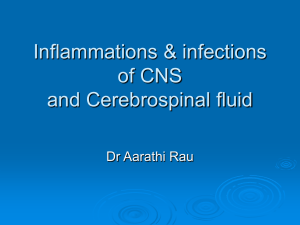
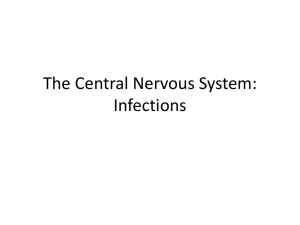
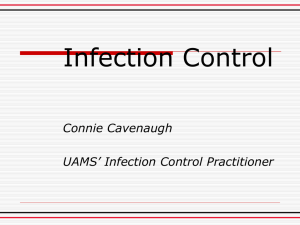
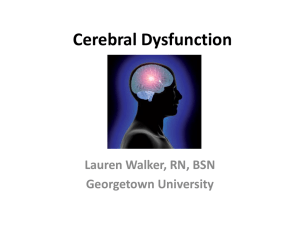
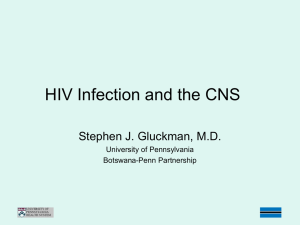
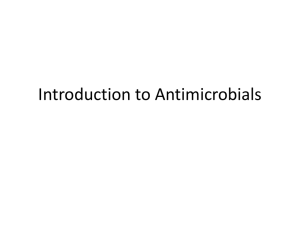
![MENINGITIS[2]](http://s2.studylib.net/store/data/005749244_1-0310b36bca6c7b9165194f04ae7a6bf6-300x300.png)
